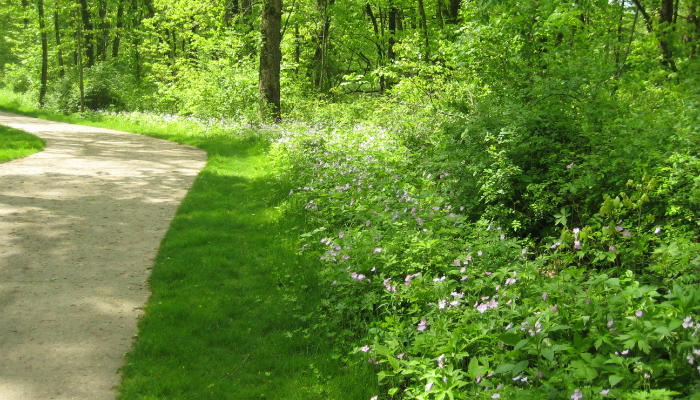Clear Some Woods for Wild Geranium

Two decades ago I noticed a farmer re-fencing a pasture near Frytown. I remembered when it had been oak-hickory forest, and the stumps were still there. The roadside ditch outside the fence was a jungle of weeds and brush, but scattered in it there were occasional jack in the pulpit, wild ginger, spring beauty, and wild geranium, which had seeded themselves from under the former trees. Before fencing, the farmer mowed the ditch several times with a bush hog. The next May, the ditch was awash with flowering wild geraniums.
In summer 2012, Connie Mutel sponsored a tour around her home, which is a cabin in the woods. The previous autumn, Liz Maas and her associates had burned the woods right up close to Connie’s home, and in May 2012 the burned portion had erupted into a carpet of flowering wild geraniums, a display Connie had not witnessed there before.
This spring, another place to see wild geraniums respond to woodland floor clearing is where the Clear Creek Trail passes through the former Camp Cardinal, today Rotary Camp Park. In the photo, the grass strip right beside the trail was planted on rototilled dirt, and all native plants are gone. But the next layer, lush with wild geranium in late May, was simply cleared of brush and maintained by mowing once or twice a year in autumn. The enclosing woods are heavily overgrown with alien brush, but still does contain a few blooming wild geranium and probably many more alive but suppressed by the brush.
This is a consistent pattern for wild geranium, being able to barely survive in overgrown woodlands for decades and then flourishing again once released by brush removal. Other spring ephemerals also have this ability, but usually aren’t dense enough to create a flashy display.
The Asian honeysuckles are the worst offenders in overgrown woodlands because they leaf out long before the canopy trees, and can leave the spring ephemerals in complete shade for their entire brief growing season, depriving them of the photosynthetic energy needed to flower and fruit. But these honeysuckle’s great vulnerability is that they are still leafed out in late autumn when everything else is dormant, which lends itself to several herbicide strategies with no risk to the natives, including cut stump treatment of large bushes, or directly spraying the leaves of smaller ones, using glyphosate, which will have no carryover to the next growing season for the trees or wildflowers.
But whether by mowing, cutting, or herbicide treatment, you could be in for a treat with swaths of showy native wild geraniums when you clear out the underbrush in your woods, if you already had a scattering of suppressed survivors doing their best to flower.


